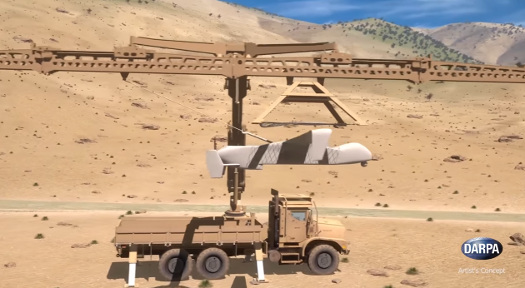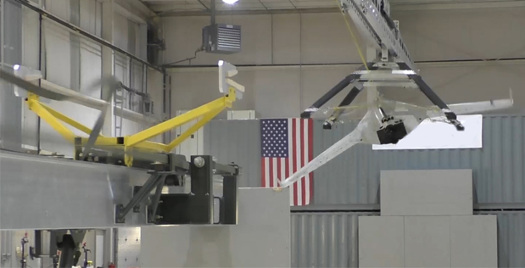 |
| February 21, 2017 | Volume 13 Issue 07 |
Designfax weekly eMagazine
Archives
Partners
Manufacturing Center
Product Spotlight
Modern Applications News
Metalworking Ideas For
Today's Job Shops
Tooling and Production
Strategies for large
metalworking plants
DARPA mechanical arm prototype catches, launches heavy-duty drones

DARPA's SideArm research effort aims to create a self-contained, portable apparatus able to horizontally launch and retrieve unmanned aerial systems (UASs) up to 900 lb from trucks, ships, and fixed bases.
Few scenes capture the U.S. Navy's prowess as effectively as the rapid-fire takeoff and recovery of combat jets from the deck of an aircraft carrier. The ability to carry air power anywhere in the world, and both launch those aircraft to flight speed and bring them to a stop over extremely short distances, has been essential to carriers' decades-long dominance of naval warfare. To help provide similar capabilities -- minus the 90,000-ton carriers -- to U.S. military units around the world, DARPA's SideArm research effort seeks to create a self-contained, portable apparatus able to horizontally launch and retrieve unmanned aerial systems (UASs) up to 900 lb.
In December 2016, Aurora Flight Sciences successfully tested a full-scale technology demonstration system that repeatedly captured a 400-lb Lockheed Martin Fury UAS accelerated to representative flight speeds via an external catapult. The system is capable of recovering aircraft up to 1,100 lb, exceeding DARPA's design objectives.

Aurora Flight Sciences recently tested a full-scale SideArm technology demo system that repeatedly captured a Lockheed Martin Fury UAS accelerated to representative flight speeds via an external catapult.
The SideArm prototype fits in the footprint of a standard 20-ft shipping container for easy transport by truck, ship, rail, C-130 transport aircraft, and CH-47 heavy-lift helicopter. The small-footprint system is designed to operate in truck-mounted, ship-mounted, and standalone/fixed-site facilities. A crew of only two to four people can set up or stow the system in minutes.
SideArm owes its small size to combining its launch and capture equipment into a single rail that folds for transport. Rather than using a traditional capture method that uses a net to catch the UAS, the system snags a hook on the back of the vehicle and directs the hook to travel down the rail. This approach provides slower, more constant and controlled deceleration, which is safer for the vehicle.
VIDEO: DARPA's SideArm research effort seeks to create a self-contained, portable apparatus able to horizontally launch and retrieve unmanned aerial systems (UASs) up to 900 lb.
"SideArm aims to replicate carriers' capability to quickly and safely accelerate and decelerate planes through a portable, low-cost kit that is mission-flexible, independent from local infrastructure, and compatible with existing and future tactical unmanned aircraft," says Graham Drozeski, DARPA program manager.
"We've demonstrated a reliable capture mechanism that can go anywhere a 20-ft container can go -- the DARPA-worthy challenge we had to overcome to make SideArm's envisioned capabilities possible," says Drozeski. "We are pleased with the progress we've made enabling a wide variety of sea- and land-based platforms with persistent intelligence, surveillance, and reconnaissance (ISR) and strike capabilities."
SideArm is part of DARPA's individual investment in Phase 1 research for Tern, a joint program between DARPA and the U.S. Navy's Office of Naval Research (ONR). Now that the demonstration of the capture system is complete, DARPA is working to identify potential transition partners and exploring using SideArm with other UAS platforms.
VIDEO: Catchin' it old style. In this 2014 video, see a Lockheed Martin Fury launched via catapult and then caught in a net.
Source: DARPA
Published February 2017
Rate this article
View our terms of use and privacy policy
